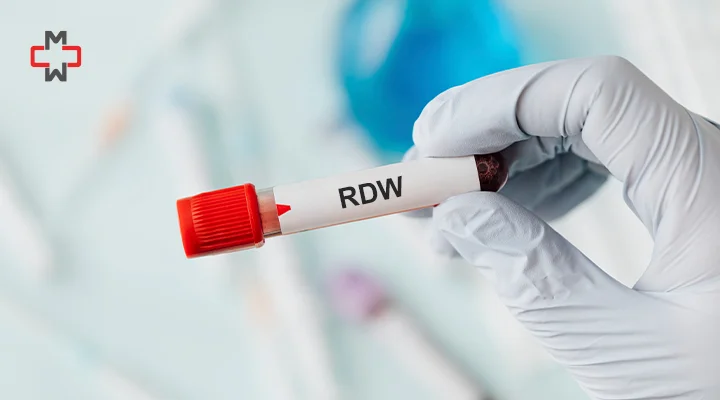What is The RDW Blood Test?
The RDW blood test is a vital part of a complete blood count (CBC test) that assesses the variation in the size of red blood cells (RBCs). Red Cell Distribution Width identifies and measures the non-uniformity of size in the red blood cells. This test helps healthcare providers diagnose various blood disorders and monitor treatment responses.
When is The RDW Blood Test Needed?
The RDW blood test is essential for various situations where high RDW symptoms and conditions point toward potential blood disorders or health complications.Here are the high RDW symptoms and conditions that require RDW blood tests:
- Fatigue: Persistent fatigue or weakness that is often accompanied by other symptoms.
- Pale Skin: Unusually pale skin can indicate decreased red blood cell count or anemia, prompting the need for an RDW blood test.
- Shortness of Breath: Difficulty breathing or shortness of breath, particularly during exertion, may also indicate underlying cardiovascular or respiratory issues that require an Red Cell Distribution Width.
- Dizziness: Frequent episodes of dizziness or lightheadedness could hint at anemia or other blood-related disorders, warranting an RDW blood test.
- Anemia: Anemia, characterized by a deficiency of red blood cells or hemoglobin, is a common condition that often requires an RDW blood test for diagnosis and monitoring.
- Nutritional Deficiencies: Deficiencies in essential nutrients such as iron, folate, or vitamin B12 can lead to abnormalities in red blood cell size and distribution, prompting the need for a Red Cell Distribution Width.
- Bone Marrow Disorders: Conditions affecting the bone marrow’s ability to produce healthy blood cells, such as aplastic anemia or myelodysplastic syndromes, may necessitate an RDW blood test for diagnosis and monitoring.
- Chronic Diseases: Chronic diseases like kidney disease, liver disease, or autoimmune disorders can impact the production or function of red blood cells, necessitating regular RDW blood testing to assess overall health status.
What Does An RDW Blood Test Measure?
The RDW blood test, or Red Cell Distribution Width measures the following:
- Variability in the Size of Red Blood Cells: The RDW blood test assesses the range of sizes and distribution among red blood cells (RBCs) in a blood sample.
- Anemia Detection: High RDW levels often point at a wider range of RBC sizes, indicating different types of anemia. Anemia is a condition characterized by a deficiency in the number or quality of red blood cells.
- Diagnostic Aid: The Red Cell Distribution Width is a diagnostic aid for various blood disorders, including nutritional deficiencies, bone marrow disorders, and chronic diseases.
- Monitoring Treatment Response: Monitoring changes in RDW levels over time can help evaluate the effectiveness of treatment for conditions such as anemia or other blood disorders.
What Level of RDW is Dangerous?
Knowing what level of RDW is dangerous, is essential for early intervention and prevention. High RDW levels beyond the RDW normal range often signal underlying health issues – potentially increasing the risk of cardiovascular events, strokes, and mortality. However, the interpretation of RDW levels must consider individual health factors and medical history.
What is An RDW Normal Range?
The RDW normal range typically falls between 11.5% and 14.5% – However, this range may vary slightly among different laboratories and populations.
Deviations from this RDW normal range warrant further investigation to confirm the underlying cause and initiate appropriate treatment strategies.
How Does An RDW Blood Test Work?
The RDW blood test is conducted using automated analyzers that measure the width of red blood cells and calculate the coefficient of variation.
This process enables the determination of RDW values, reflecting the heterogeneity of RBC sizes within a blood sample. Healthcare providers explain these values along with other blood parameters to make informed diagnostic decisions.
How Do You Prepare For The RDW Blood Test?
Preparing for an RDW blood test is quite simple and requires minimal specific preparation. Here are some of the essential steps to consider:
- Inform Your Healthcare Provider: Notify them of any medications, supplements, or herbal remedies you use.
- Stay Hydrated: Drink plenty of water beforehand.
- Avoid Strenuous Exercise: Refrain from intense physical activity.
- Follow Fasting Instructions: If required, adhere to fasting guidelines.
- Get Adequate Rest: Prioritize rest and sleep.
- Dress Comfortably: Wear loose clothing for easy access.
- Stay Calm and Relaxed: Use relaxation techniques if anxious.
Frequently Asked Questions
Is low RDW bad?
Low RDW is not necessarily bad, but it does indicate uniformity in red blood cell size. It's essential to interpret RDW levels in context with other blood parameters and medical history.
Can high RDW be treated?
High RDW can be indicative of various underlying conditions. Treatment depends on identifying and addressing the root cause, such as anemia, nutrient deficiencies, or chronic diseases.
What does a 12.9 RDW mean?
An RDW level of 12.9 falls within the normal range (typically 11.5% to 14.5%). It suggests relatively uniform red blood cell sizes and is usually considered a healthy result.
What level of RDW is dangerous in pregnancy?
In pregnancy, RDW levels outside the normal range may indicate potential complications. However, the threshold for dangerous RDW levels can vary based on individual health factors and should be assessed by a healthcare provider.
– Disclaimer –
This blog is for informational & educational purposes only, and does not intend to substitute any professional medical advice or consultation. For any health related concerns, please consult with your physician, or call 911.
-
About The Author
Dr. Syra Hanif M.D.Board Certified Primary Care Physician
Dr. Syra Hanif is a board-certified Primary Care Physician (PCP) dedicated to providing compassionate, patient-centered healthcare.
Read More







